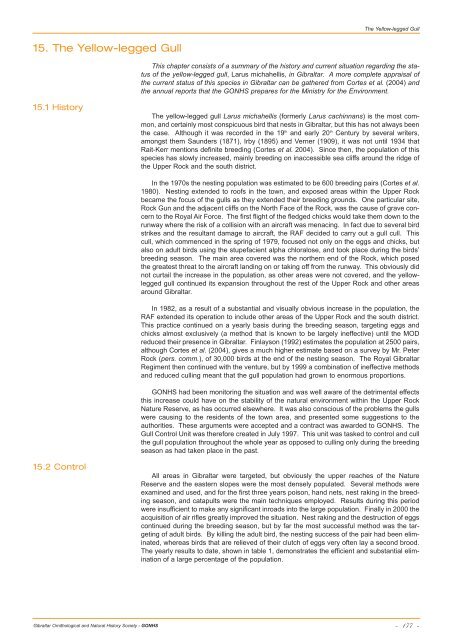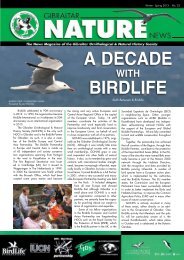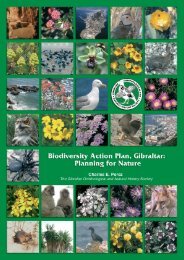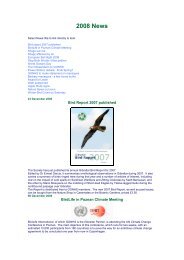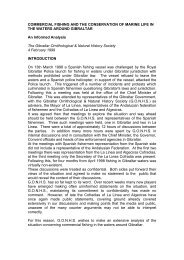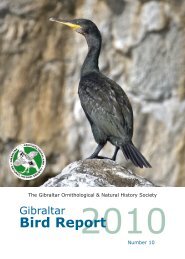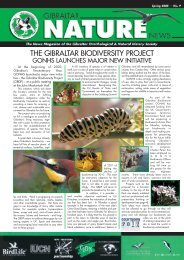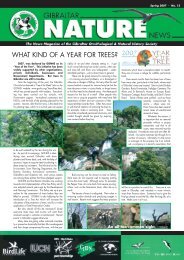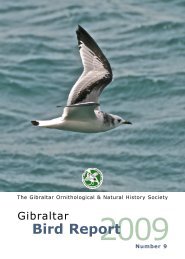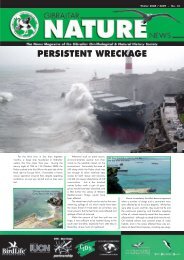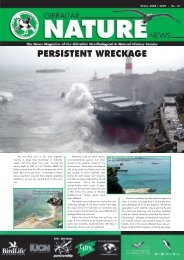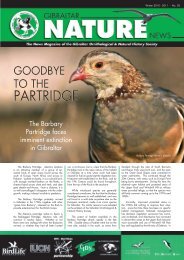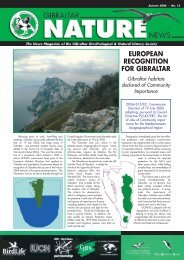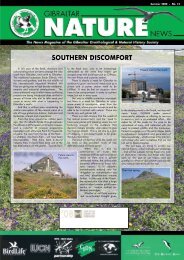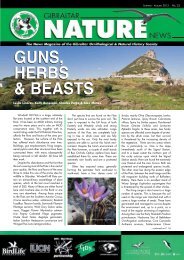Upper Rock Nature Reserve: A Management and Action Plan
Upper Rock Nature Reserve: A Management and Action Plan
Upper Rock Nature Reserve: A Management and Action Plan
You also want an ePaper? Increase the reach of your titles
YUMPU automatically turns print PDFs into web optimized ePapers that Google loves.
15. The Yellow-legged Gull<br />
15.1 History<br />
15.2 Control<br />
Gibraltar Ornithological <strong>and</strong> Natural History Society - GONHS<br />
The Yellow-legged Gull<br />
This chapter consists of a summary of the history <strong>and</strong> current situation regarding the status<br />
of the yellow-legged gull, Larus michahellis, in Gibraltar. A more complete appraisal of<br />
the current status of this species in Gibraltar can be gathered from Cortes et al. (2004) <strong>and</strong><br />
the annual reports that the GONHS prepares for the Ministry for the Environment.<br />
The yellow-legged gull Larus michahellis (formerly Larus cachinnans) is the most common,<br />
<strong>and</strong> certainly most conspicuous bird that nests in Gibraltar, but this has not always been<br />
the case. Although it was recorded in the 19 th <strong>and</strong> early 20 th Century by several writers,<br />
amongst them Saunders (1871), Irby (1895) <strong>and</strong> Verner (1909), it was not until 1934 that<br />
Rait-Kerr mentions definite breeding (Cortes et al. 2004). Since then, the population of this<br />
species has slowly increased, mainly breeding on inaccessible sea cliffs around the ridge of<br />
the <strong>Upper</strong> <strong>Rock</strong> <strong>and</strong> the south district.<br />
In the 1970s the nesting population was estimated to be 600 breeding pairs (Cortes et al.<br />
1980). Nesting extended to roofs in the town, <strong>and</strong> exposed areas within the <strong>Upper</strong> <strong>Rock</strong><br />
became the focus of the gulls as they extended their breeding grounds. One particular site,<br />
<strong>Rock</strong> Gun <strong>and</strong> the adjacent cliffs on the North Face of the <strong>Rock</strong>, was the cause of grave concern<br />
to the Royal Air Force. The first flight of the fledged chicks would take them down to the<br />
runway where the risk of a collision with an aircraft was menacing. In fact due to several bird<br />
strikes <strong>and</strong> the resultant damage to aircraft, the RAF decided to carry out a gull cull. This<br />
cull, which commenced in the spring of 1979, focused not only on the eggs <strong>and</strong> chicks, but<br />
also on adult birds using the stupefacient alpha chloralose, <strong>and</strong> took place during the birds’<br />
breeding season. The main area covered was the northern end of the <strong>Rock</strong>, which posed<br />
the greatest threat to the aircraft l<strong>and</strong>ing on or taking off from the runway. This obviously did<br />
not curtail the increase in the population, as other areas were not covered, <strong>and</strong> the yellowlegged<br />
gull continued its expansion throughout the rest of the <strong>Upper</strong> <strong>Rock</strong> <strong>and</strong> other areas<br />
around Gibraltar.<br />
In 1982, as a result of a substantial <strong>and</strong> visually obvious increase in the population, the<br />
RAF extended its operation to include other areas of the <strong>Upper</strong> <strong>Rock</strong> <strong>and</strong> the south district.<br />
This practice continued on a yearly basis during the breeding season, targeting eggs <strong>and</strong><br />
chicks almost exclusively (a method that is known to be largely ineffective) until the MOD<br />
reduced their presence in Gibraltar. Finlayson (1992) estimates the population at 2500 pairs,<br />
although Cortes et al. (2004), gives a much higher estimate based on a survey by Mr. Peter<br />
<strong>Rock</strong> (pers. comm.), of 30,000 birds at the end of the nesting season. The Royal Gibraltar<br />
Regiment then continued with the venture, but by 1999 a combination of ineffective methods<br />
<strong>and</strong> reduced culling meant that the gull population had grown to enormous proportions.<br />
GONHS had been monitoring the situation <strong>and</strong> was well aware of the detrimental effects<br />
this increase could have on the stability of the natural environment within the <strong>Upper</strong> <strong>Rock</strong><br />
<strong>Nature</strong> <strong>Reserve</strong>, as has occurred elsewhere. It was also conscious of the problems the gulls<br />
were causing to the residents of the town area, <strong>and</strong> presented some suggestions to the<br />
authorities. These arguments were accepted <strong>and</strong> a contract was awarded to GONHS. The<br />
Gull Control Unit was therefore created in July 1997. This unit was tasked to control <strong>and</strong> cull<br />
the gull population throughout the whole year as opposed to culling only during the breeding<br />
season as had taken place in the past.<br />
All areas in Gibraltar were targeted, but obviously the upper reaches of the <strong>Nature</strong><br />
<strong>Reserve</strong> <strong>and</strong> the eastern slopes were the most densely populated. Several methods were<br />
examined <strong>and</strong> used, <strong>and</strong> for the first three years poison, h<strong>and</strong> nets, nest raking in the breeding<br />
season, <strong>and</strong> catapults were the main techniques employed. Results during this period<br />
were insufficient to make any significant inroads into the large population. Finally in 2000 the<br />
acquisition of air rifles greatly improved the situation. Nest raking <strong>and</strong> the destruction of eggs<br />
continued during the breeding season, but by far the most successful method was the targeting<br />
of adult birds. By killing the adult bird, the nesting success of the pair had been eliminated,<br />
whereas birds that are relieved of their clutch of eggs very often lay a second brood.<br />
The yearly results to date, shown in table 1, demonstrates the efficient <strong>and</strong> substantial elimination<br />
of a large percentage of the population.<br />
- 177 -


